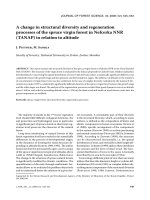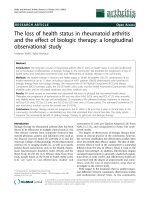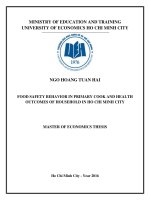Available Zinc status in relation to soil properties in some red and lateritic Soils of Birbhum district, West Bengal, India
Bạn đang xem bản rút gọn của tài liệu. Xem và tải ngay bản đầy đủ của tài liệu tại đây (204.86 KB, 7 trang )
Int.J.Curr.Microbiol.App.Sci (2019) 8(5): 1764-1770
International Journal of Current Microbiology and Applied Sciences
ISSN: 2319-7706 Volume 8 Number 05 (2019)
Journal homepage:
Original Research Article
/>
Available Zinc Status in Relation to Soil Properties in some Red and
Lateritic Soils of Birbhum District, West Bengal, India
C.P. Mohammed Nisab*, G.K. Ghosh and Mamta Sahu
Department of Soil science and Agricultural Chemistry, PalliSiksha Bhavana,
Visva-Bharati, India
*Corresponding author
ABSTRACT
Keywords
Physico-chemical
properties, DTPAextractable,
Correlation
Article Info
Accepted:
15 April 2019
Available Online:
10 May 2019
The present study was undertaken to assess the status of available Zinc in relation to soil
physico-chemical properties in nineteen soil samples collected from three different blocks
of Birbhum district of West Bengal. In general, textural class ranged from sandy loam to
sandy clay loam. Soils were strong to moderately acidic in reaction. Soil organic carbon
status ranged from 0.24 to 0.81% and was low in available P status. The DTPA-extractable
zinc content in the surface soils under study, varied from 0.37 to 1.28 mg kg -1 with an
average value 0.856 mg kg-1. Among the samples analyzed, 18% deficient, 67% sufficient
and 13% samples were found to be high level in available Zn content in soil. Correlation
between the soil physico-chemical properties and available zinc showed a significant and
positive relationship with clay content (r =0.535**) and organic matter (r = 0.362**),
whereas negative and significant correlation was noticed with soil pH (r = -0.233*) and
available P (r= -0.588**).
Introduction
Zinc deficiency is prevalent worldwide in
temperate and tropical climates (Slaton et al.,
2005, Prasad 2006, Fageria et al., 2011).
Indian soils are prone to micronutrient deficit
due to intensive cultivation of high yielding
varieties and improper nutrient management
including
high
rate
application
of
macronutrients and use of low levels of
organic matter (Mathur et al., 2006;
Somasundaram et al., 2009; Sharma et al.,
2009). Zinc is essential for particular
physiological functions in living systems; it
plays an important role in different plant
metabolism processes like development of
cell wall, respiration, photosynthesis,
chlorophyll formation, enzyme activity and
other bio-chemical functions (Das, 2003). It
helps the maintenance of structural and
functional integrity of biological membranes
(Alloy, 2008 and Hafeez et al., 2013).
Availability of zinc influenced by numerous
soil parameters like, soil pH, organic matter
content, adsorptive surfaces, and other
physical, chemical, and biological conditions
in the rhizosphere zone (Pati and
Mukhopadhyay, 2011).
High phosphate content of soils or high
fertilization with phosphate may reduce the
1764
Int.J.Curr.Microbiol.App.Sci (2019) 8(5): 1764-1770
uptake of zinc and other nutrients (Dadhich
and Somani, 2007; Kizilgoz and Sakin, 2010).
Analysis of soil and plant samples has
indicated that about 49% of soils in India are
potentially deficient in Zn (Singh M.V., 2008
and Gupta, 2005). In West Bengal, 55% of the
soils are found to be deficient in Zn (Takkar
et al., 1989). Therefore, the objective was
framed to study the available zinc status in
relation to soil physico-chemical properties of
Birbhum district of West Bengal.
Materials and Methods
Study area
Situated between 23° 32' 30" (right above
the tropic of cancer) and 24° 35' 0" north
latitude and 87° 5' 25" and 88° 1' 40" east
longitudes, and about 4,545 square kilometres
in area. Geographically, this area lies at the
north eastern end of the Chota Nagpur
Plateau, as it slopes down and merges with
the alluvial plains of the Ganges. The climate
on the western side is dry and extreme but is
relatively milder on the eastern side. During
summer, the temperature can shoot well above
40 °C (104 °F) and in winters it can drop to
around 10 °C (50 °F). Rainfall is higher in the
western areas as compared to the eastern
areas.
Soil sampling and analysis
Thirty soil samples (0-15cm) were collected
from each three blocks namely Md. Bazar,
Nalhati and Bolpur of Birbhum district, were
air dried, ground in a wooden mortar, passed
through 2 mm sieve and stored in polythene
bags for various analysis.
Soil analysis
Particle size analysis was carried out by
Hydrometer method using sodium hexa meta
phosphate as a dispersing agent as described
by Bouyoucos (1927). Soil reaction (pH) was
measured in 1:2.5 soil: water suspension with
a digital glass electrode pH meter (Jackson
1973). Electrical conductivity was measured
using conductivity meter as outlined by
Jackson (1973) under suitable measuring
conditions. Walkley and Black’s (1934) wet
oxidation method was used for determination
of organic carbon (OC). Available phosphorus
was extracted with Bray No-1 solution as
extractant
(Bray,
1945)
and
using
spectrophotometer at wave length of 660 nm.
Plant available (DTPA–extractable) zinc in
soils was extracted using DTPA (0.005 M
DTPA + 0.01 M CaCl2 + 0.1 M TEA, pH 7.3)
at 1:2 soil to extractant ratio as described by
Lindsay and Norwell (1978). Based on the
available soil Zn status, the soils were
grouped into three categories as, deficient (≤
0.6), sufficient (0.6-1.2), and high ≥ 1.2 mg
kg-1 of soil available Zn.
Statistical analysis
The results obtained in respect of soil
properties were subjected for simple
correlation analysis and the observed ‘r’
values were tested for 1% and 5% level of
significance (Sundarraj et al., 1972).
Results and Discussion
The various physico chemical properties in
soils of three different blocks of Birbhum
district used in the study are given in Table 1.
The mechanical composition of soil indicated
that the texture varied from sandy loam to
sandy clay loam texture.
Sand was the dominant fraction in these soils,
which might be due to high rainfall and the
parent material from which the soil was
derived. The results of the study were in
conformity
with
the
findings
of
Sathyanarayana and Biswas (1970).
1765
Int.J.Curr.Microbiol.App.Sci (2019) 8(5): 1764-1770
Physicochemical properties
The pH of the surface soils under present
investigation showed that most of the soils are
strong to moderately acidic in nature. Acidic
pH of the soils might be attributed to the type
of parent material from which these soils have
been derived and leaching of basic cations.
This is in agreement with the findings of
Chakravarti et al., (1957), who stated that
soils of Birbhum districts are acidic in nature.
Electrical conductivity in the soils under
study and was found to be normal with
respect to plant growth, which may be due to
low in salt concentration as observed by
Chakravarti et al., (1957) and Ray et al.,
(2012).
Soil organic carbon status in soils of three
different blocks ranged from 0.24 to 0.73 %,
0.28 to 0.76 % and 0.25 to 0.81%
respectively. Soils from Nalhati blocks
showed high amount of organic carbon
content. Organic carbon content in most of
the soil showed low to medium in range. This
might be due to continuous cultivation and
scarce application of FYM.
The overall available P of the study area was
noted from 12.04 to 42.4 kg ha-1 with a mean
value of 27.09 kg ha-1, majority of the soils
under study showed low available P status.
The low available P status in these soils might
be due to acidic nature of soil. This result
agrees with observations of Deshmukh
(2012), Pandit et al., (2016) and Das et al.,
(2010).
DTPA available Zn content
The DTPA-extractable zinc content in the
surface soils under study, varied from 0.37 to
1.28 mg kg-1 with an average value 0.856 mg
kg-1. The overall samples were found to be
18% in deficient, 67% in sufficient and only
13% samples were found to be high level in
available Zn content in soil (Fig. 1). Soils of
Nalhati block were found to contain higher
amount of DTPA-extractable zinc compared
to Md. Bazar and Boplur block soils due to
the high organic carbon content as noticed in
the present study. The similar results were
observed
by
Krishnamurthy
and
Srinivasamurthy (2001) and Chidanandappa
et al., (2008) and Kumar (2017).
Relationship between DTPA-extractable
zinc and soil properties
The data on correlation between soil
properties and available zinc status in top soil
of Birbhum district were presented in table 2.
The current study showed that, DTPAextractable zinc exhibit positive and
significant correlation with clay content (r =
0.535**) and organic matter (r = 0.362**),
whereas negative and significant correlation
with soil pH (r =-0.233*) and available P (r= 0.588**).
The positive correlation between available
zinc and clay content indicates that available
zinc status increases with increasing fineness
of the soil texture, which helpful to improve
soil structure and aeration which are favorable
conditions for increasing its availability,
similar observation was made by Kumar et
al., (2011) and Meena et al., (2017).
Similarly the available zinc status in soils
under study increases with organic matter
content which may due to the organic acids or
compounds
produced
during
the
decomposition of organic matter react with
zinc and form soluble organo-zinc complexes,
which prevent the zinc from fixation by soil
constituents and which supply soluble
chelating agents which increase the solubility
of micronutrient contents, which is in line
with findings of Begum et al., (2016), Kumar
(2017) and Rai et al., (2018).
1766
Int.J.Curr.Microbiol.App.Sci (2019) 8(5): 1764-1770
Table.1 Physico-chemical characteristics in the soils of Birbhum district
BLOCK
pH
Md. Bazar
Nalhati
Bolpur
Range
Mean
Range
Mean
Range
Mean
4.35-5.84
4.90
5.91-6.94
6.47
4.66-5.75
4.92
EC
(dSm-1)
0.01-0.08
0.04
0.01-0.07
0.03
0.01-0.07
0.03
Organic C
(%)
0.24-0.73
0.47
0.28-0.76
0.56
0.25-0.81
0.49
Available P
(kg/ha)
9.08-43.31
26.38
18.02-42.89
29.72
9.21-41.0
25.8
DTPA-Zn
(mg/kg)
0.33-1.30
0.84
0.35-1.26
0.88
0.45-1.28
0.85
Textural
Class
SCL
SCL
SCL
Table.2 Correlation in between DTPA-extractable zinc and physico- chemical properties in soils
of Birbhum district
Properties
DTPA-Zn
pH
OC
Clay
Available P
DTPA-Zn
1.00
-0.233*
0.362**
0.535**
-0.588**
pH
OC
1.00
0.068
0.272**
0.500**
1.00
0.146
-0.201
Clay
1.00
-0.465**
Available P
1.00
* - Significant at 5 % ** - Significant at 1 %
Fig.1 Status of DTPA available Zn in 3 blocks under Birbhum district
The correlation study suggests that zinc
availability decreased with increase in soil pH
and available P content probably due to the
increased solubility of oxides and hydroxides
of Zn at lower pH condition (Talukdar et al.,
2009) and formation of insoluble zinc
hydroxide and zinc carbonate at higher pH,
fixation of zinc by clay in soil and the
antagonistic effect of zinc with available P,
which is in similarity with findings of Ray et
al., (2016).
From the results under this study it can be
concluded that available Zn concentrations of
1767
Int.J.Curr.Microbiol.App.Sci (2019) 8(5): 1764-1770
these soils are generally sufficient, whereas
18% of soils under study showed low in
available zinc status, the availability of zinc
increased with clay content and soil organic
matter, whereas it decreased with soil pH and
available P in soil. The present investigation
may helpful for the improving the nutrient
management in red and lateritic soils of
Birbhum district.
References
Alloway B.J. 2008. Zinc in soils and crop
nutrition. Second edition published by
IZA and IFA, Brussels, Belgium, Paris
and France, 59-74.
Begum, K., Hossain, M. D. F., and Parveen,
Z. 2016. Distribution of zinc fractions
in relation to properties of some soils
of Bangladesh, Dhaka Univ. J. Biol.
Sci. 25(1): 19-25.
Bouyoucos, G. J. 1951. A recalibration of
hydrometer method for making
mechanical analysis of soil. Agron. J.
43; 434-438.
Bray, R. H., and Kurtz, L. T. 1945.
Determination of total, organic, and
available forms of phosphorus in soils.
Soil Science, 59: 39-45.
Chakravarti, P., and Chakravarti, S. 1957.
Soils of West Bengal, Agricultural
research institute, Culcutta. vol 23B.
Dadhich, S. K., and Somani, L. L. 2007.
Effect
of
integrated
nutrient
management in Soybean-Wheat crop
sequence on the yield, micronutrient
uptake and post-harvest availability of
micronutrients on Typic Ustochrepts
soil. Acta Agronomica Hungarica, 55
(2): 205–216.
Das, A., Patel, D. P., Munda, G. C., and Gosh,
P. K. 2010. Effect of organic and
inorganic sources of nutrients on
yield, nutrient uptake and soil fertility
of maize (Zea mays)- Mustard
(Brassica
campestris)
cropping
system. Indian
Journal
of
Agricultural Sciences, 80(1):85-88.
Das, D.K. 2003. Micronutrients: Their
Behavior in Soils and Plants, Kalyani
Publishers, New Delhi.
Deshmukh, K. K. 2012. Evaluation of soil
fertility status from Sangamnar area,
Ahmednagar district, Maharashtra.
Rasayan Journal Chemicals, 5 (3),
398-406.
doi:
/>07.012.
Fageria, N.K., Dos Santos, A. B., and
Cobucci, T. 2011. Zinc nutrition of
lowland rice. Communication in Soil
Science and Plant Analysis. 42: 1719–
27.
Gupta, A. P. 2005. Micronutrient status and
fertilizer use scenario in India. Journal
of Trace Elements in Medicine and
Biology, 18, 325-331.
Hafeez B, Khanif, Y.M., Samsuri, A.W.,
Radziah, O., Zakaria, W., and Saleem,
M. 2013. Direct and Residual Effect
of Zinc on Zinc Efficient and
Inefficient Rice Genotypes Grown
under Less Zinc Content Submerged
Acidic Condition. Comm. Soil Sci.
Plant Analysis, 1-9.
Jackson, M.L. 1973. Soil Chemical Analysis.
Prientice Hall of India Pvt. Ltd. New
Delhi.
Kizilgoz, I., and Sakin, E. 2010. The effects
of increased phosphorus application
on shoot dry matter, shoot P and Zn
concentrations in wheat (Triticum
durum L.) and maize (Zea mays L.)
grown in a calcareous soil. African
Journal of Biotechnology, 9(36):
5893-5896.
Krishnamurthy, R., and Srinivasamurthy, C.
A. 2001. Distribution of some
available micronutrients in black and
red soils of Karnataka. Mysore J.
Agric. Sci., 39 (1): 57-63.
Kumar, M. B., Subbarayappa, C. T., and
1768
Int.J.Curr.Microbiol.App.Sci (2019) 8(5): 1764-1770
Ramamurthy, V. 2017. Distribution
of Available (DTPA-extractable) Zinc
and Iron and their Relationship with
Some Soil Properties in Rice Soils of
Chamarajanagar District, Karnataka,
India. International Journal of
Current Microbiology and Applied
Sciences, 6(5), pp. 1423-1428.
Kumar, M., and Babel, A, L. 2011. Available
micronutrient
status
and
their
relationship with soil properties of
Jhunjhunu Tehsil, District Jhunjhunu,
Rajasthan.
India
Journal
of
Agricultural Sciences, 3:20-31.
Lindsay, W.L., and Norvell, W.A. 1978
Development of a DTPA soil test for
zinc, iron, manganese and copper. Soil
Sci. Soc. Am. J.; 42:421-428.
Mathur, G. M., Deo, R. and Yadav, B. S.
2006. Status of zinc in irrigated northwest plain soils of Rajasthan.
Medicine and Biology, 18 (4) 325-331.
Meena, R.S., and Mathur, A.K. 2017.
Available Micronutrients in Relation
to Soil Properties of Ghatol Tehsil,
Banswara District of Rajasthan.
Int.J.Curr.Microbiol.App.Sci.
6(7):
102-108.
Pandit, T. K., and Mookherjee, S. 2016,
Evaluation of soil fertility status in old
alluvial zone of West Bengal.
International Journal of Agricultural
science and Research.
Pati, R., and Mukhopadhyay, D. 2011.
Distribution of cationic micronutrients
in some acid soils of West Bengal.
Journal of Indian Society Soil Science
59, 125-133.
Prasad, R. 2006. Zinc in soils and in plant,
human and animal nutrition. Indian
Journal of Fertility. 2: 103–19.
Rai, P., Phuntsog, T., Mondal , A. K., Kumar,
A.,Samanta , Kumar, M., Arora, R. K.,
and Dwivedi, M.C. 2018. Cationic
Micronutrient Status of Some Soils
under Different Cropping System of
Kishtwar District (J&K), India.
International Journal of Current
Microbiology and Applied Sciences.
Ray, S. K., and Banik, G. 2016. Available
micronutrient status in relation to soil
properties in some villages under four
agro-climatic features of West Bengal.
Journal of the Indian Society of Soil
Science, 2(64), pp 169-175, DOI:
10.5958/0974-0228.2016.00022.0.
Ray, S. K., and Mukhopadhyay, D. 2012. A
study on physicochemical properties
of soils under different Tea growing
regions of West Bengal. International
Journal of Agriculture Sciences, 4:(8),
325-329.
Sathyanarayana, T., and Biswas, T. D. 1970.
Chemical and mineralogical studies of
associated red and black soils. Mysore
J. Agril. Sci., 4: 253-262.
Sharma, B.D., Raj K., Singh, B. and Sethia,
M. 2009. Micronutrients distribution
in salt affected-soils of the Punjab in
relation to soil properties. Archives of
Agronomy and Soil Science, 55:367
377.
Singh, M.V. 2008. Micronutrient Nutritional
Problems in Soils of India and
improvement for Human and Animal
Health. Indian J. Fert. 5(4):11-16.
Slaton, N.A., Normon, R.J., and Wilson, C.E.
2005. Effect of Zn source and
application time on Zn uptake and
grain yield of flood irrigated rice.
Agronomy Journal. 92: 272–78.
Somasundaram, J., Singh, R.K., Parandiyal,
A.K. and Prasad, S.N. 2009
Micronutrient Status of Soils under
Different Land Use Systems in
Chambal Ravines. Journal of the
Indian Society of Soil Science, 57:
307-312.
Sundararaj, N., Nagaraju, S., Venkataramu,
M. N., and Jagannatha, M. K. (1972).
Design and analysis of field
experiments. Univ. Agric. Sci.,
1769
Int.J.Curr.Microbiol.App.Sci (2019) 8(5): 1764-1770
Bangalore.
Takkar, P.N., Chibba, I.M., and Mehta, S.K.
1989. Twenty Years of Coordinated
Research on Micronutrients in Soils
and Plants. Indian Institute of Soil
Science. Bhopal. ICAR Publication.
Talukdar, M.C., Basumatary, A. and Dutta,
S.K. 2009 Status of DTPA–extractable
cationic micronutrients in soils under
rice and sugarcane ecosystems of
Golaghat district in Assam. Journal of
the Indian Society of Soil Science 57,
313-316.
Walkley A., and Black, L.A., 1934. An
examination
of
methods
for
determining soil organic matter and
proposed modification of the chromic
acid titration method. Soil Sci, 37: 2934.
How to cite this article:
Mohammed Nisab, C.P., G.K. Ghosh and Mamta Sahu. 2019. Available Zinc Status in Relation
to Soil Properties in some Red and Lateritic Soils of Birbhum District, West Bengal, India.
Int.J.Curr.Microbiol.App.Sci. 8(05): 1764-1770. doi: />
1770









